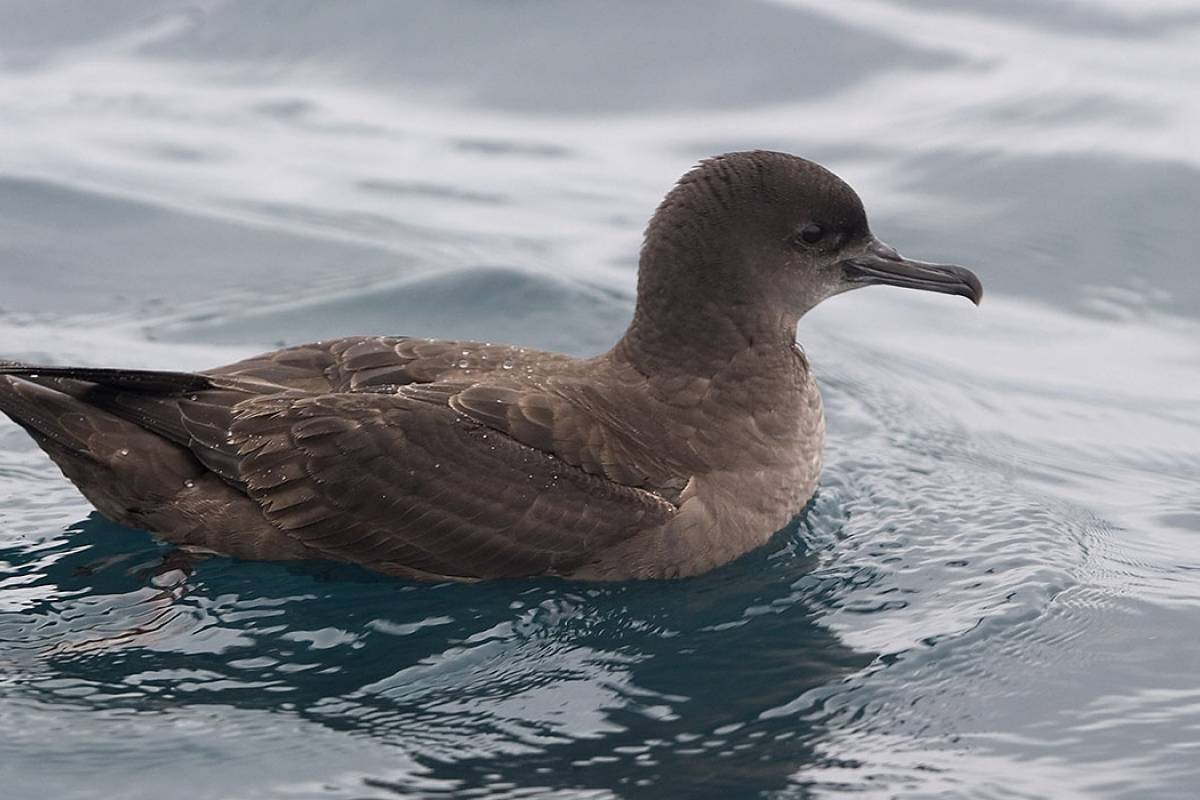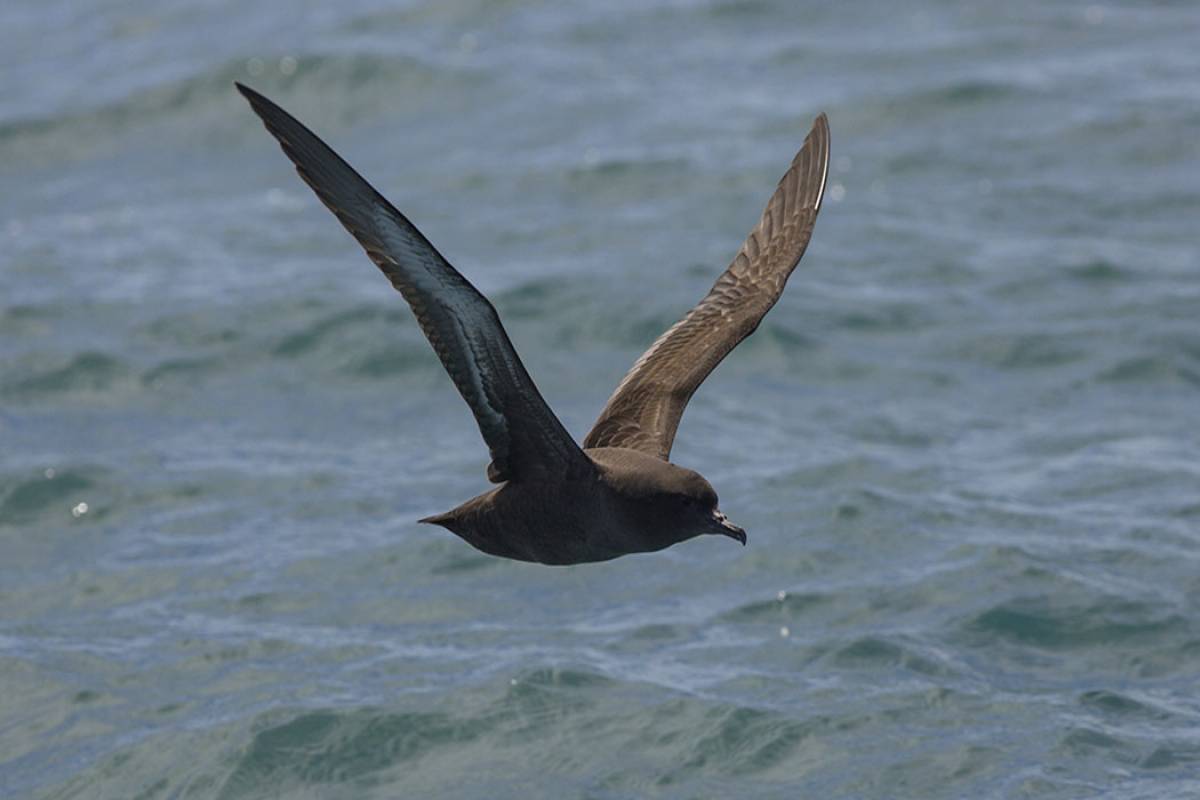Many shearwaters are long-distance migrants that are long-lived.
Shearwaters come to islands and coastal cliffs only to breed. They are nocturnal at the colonial breeding sites, preferring moonless nights to minimize predation. They nest in burrows and often give eerie contact calls on their night-time visits. They lay a single white egg.
They feed on fish, squid, and similar oceanic food. Some will follow fishing boats to take scraps, commonly the sooty shearwater. Their primary feeding technique is diving, with some species diving to depths of 70 m (230 ft).
We have ten varieties of shearwaters that can been viewed off the Kaikoura coastline.

Hutton’s Shearwater
Hutton’s shearwaters breed only on the Seaward Kaikoura Mountains at an altitude of 1200-1800metres - a most unusual place for a seabird to nest.
Given the unusual and inaccessible breeding grounds, the Hutton's shearwater (Puffinus huttoni) breeding sites were not discovered until 1965 by mountaineer Geoff Harrow. The major colony (a 1992 survey by Sherley estimated a population of about 94,000 breeding pairs) is located at the head of the Kowhai River. A second smaller colony is located further north at Puhi Peaks. In 2005 the Board of Alpine Discovery Ltd endorsed the setting up of a charitable trust for the protection of the endangered Hutton's shearwater at Puhi Peaks. It also set in motion the process to have the entire upper part of the Puhi Peaks colony area protected in perpetuity under a QEII National Trust Protection Covenant. The area is now known as the Puhi Peaks Nature Reserve.

Buller’s Shearwater
Buller’s shearwaters are seen off the Kaikoura Coast from October to May. During the height of summer, flocks of over a hundred birds can be seen.
The Buller's Shearwater (Puffinis Bulleri) breeds only on the Poor Knights Islands, just to the north of the Hauraki Gulf, 775km from Kaikoura. Back in the 1930s only 100 pairs bred there, but since the removal of pigs from the island, their numbers have grown significantly. Their growth has been particularly dramatic in the last two decades, and is now estimated at 2.5 million! Like the flesh-footed shearwater, after breeding in New Zealand Buller’s shearwaters migrate to the waters of the North Pacific, especially off Japan and Alaska. They feed on small krill and jellyfish, though in recent years they've also started to feed on food scraps thrown overboard from fishing boats. Buller’s shearwaters have a distinctive series of rapid wing beats followed by a long glide.

Sooty Shearwater
Harvested in New Zealand, being the traditional muttonbird for Southern Maori tribes with about quarter of a million chicks harvested annually.
Sooty shearwater (Puffinus griseus) is New Zealand's most common seabird, with a world population of 20 million birds. They can be seen off Kaikoura from late September to late May. Generally, only small flocks of sooty shearwaters are seen, often in association with other species of shearwaters. They feed on the bright orange krill which occurs in vast numbers off Kaikoura in the summer and autumn. Sooty shearwaters breed in New Zealand over the summer and autumn. In late autumn, they depart from New Zealand waters and migrate into the North Pacific off the coast of Japan and North America – nearly 40,000 miles (64,000 kilometres). The extensive summer trek is the longest animal migration ever recorded electronically. Sooty shearwaters are harvested in New Zealand, being the traditional muttonbird for Southern Maori tribes with about 400,000 chicks harvested annually from the Stewart Island area.

Flesh-footed Shearwater
Flesh-footed shearwaters will plunge-dive and can fly underwater to retrieve small baitfish and fish offal, therefore susceptable to being caught on long-line fish hooks.
Flesh-footed shearwaters (Puffinus carneipes) are named after the flesh-toned colouration of their feet. You'll only see them in Kaikoura from November to March, as they spend the rest of the year in the waters of the North Pacific Ocean off the coast of Japan. They breed in northern New Zealand, north of the Hauraki Gulf. There are also some smaller breeding colonies in the Marlborough Sounds. They will pursuit-dive and can fly underwater to retrieve small baitfish and fish offal, therefore being susceptible to being caught on long-line fish hooks.

Short-tailed Shearwater
Short-tailed shearwaters are seen over the summer
The short-tailed shearwaters (Puffinus tenuirostris) breed on islands around Australia, which is where they spend most of their time. But the occasional short-tailed shearwater strays across the Tasman Sea into New Zealand’s waters and is seen off Kaikoura over the summer. They look very similar to the sooty shearwater, but you can distinguish them by the colour of their underwing: the sooty shearwaters has a white underwing; the short-tailed shearwater greyish. Millions of them breed on the islands in Australia's Bass Strait, where they're harvested as muttonbirds.

Fluttering Shearwater
Fluttering shearwaters are very similar to the Hutton’s shearwater, which is far more common in the coastal waters around Kaikoura and the two species are difficult to tell apart.
Fluttering shearwaters are very similar to the Hutton's, which are far more common in Kaikoura's coastal waters and the two species are very difficult to tell apart. Small flocks of up to 100 fluttering shearwaters (Puffinus gavia) may be seen 1-2 miles off the Kaikoura Coast, although you're more likely to see them as the odd bird within flocks of thousands of Hutton's shearwaters. The fluttering shearwater breeds only in New Zealand, with main colonies in the Hauraki Gulf and Marlborough Sounds. It's a small brown and white bird, and, as the name suggests, it flies (or "flutters") just above the water with a series of rapid wing beats. It feeds by plunge-diving under the water to catch small sprats, which are normally chased close to the surface by larger predatory fish such as kahawai and barracuda.
Recent Bird Sightings
With around 150 species of birds recorded here so far, Kaikoura is one of New Zealand's top birding destinations. The wonderful array of seabirds just offshore are the jewel in the crown with five varieties of Great Albatross, nine varieties of the smaller Lesser Albatross, seven varieties of Shearwaters, fourteen Petrel varieties, and several other seabird varies such as Shags, Prions, Penguins, Gulls and Terns.